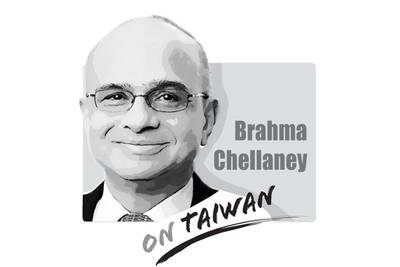Deputy Legislative Speaker Hung Hsiu-chu (洪秀柱) sparked controversy when she said that she could not say that the Republic of China (ROC) exists. Though she later played down the comment, she actually pointed out something essential in cross-strait relations — maybe it is time for Taiwan and China to recognize each other as sovereign nations.
The Chinese Nationalist Party (KMT) was defeated in the Chinese Civil War against the Chinese Communist Party and fled to Taiwan. Taiwan and China — or the ROC and the People’s Republic of China (PRC) — have virtually become two separate countries, each with its own people, territory and government. However, over the past 66 years, the two sides have been pretending that the other does not exist. The PRC claims Taiwan as a breakaway province and considers the ROC authorities a local government, while, though Taiwan has recognized the PRC as a political entity, its laws still treat both sides as two “regions” of one country with two separate governments.
Thus, President Ma Ying-jeou (馬英九) follows the so-called “1992 consensus,” saying that there is only “one China,” with each side interpreting “one China” in its own way. In simple words, the PRC could consider itself the “one China,” while the ROC could also consider itself the “one China.”
On the other hand, Hung, the KMT presidential hopeful, says that there is no need for “one China with each side having its own interpretation”; rather she insists that there is only “one China,” and the two sides should have the “same interpretation.”
Hung said she could not say that the ROC exists, otherwise she would be saying that there are two separate countries — the PRC and the ROC.
It is interesting because — whether one supports Taiwanese independence or unification with China — it is a fact that the ROC and PRC coexist and that is the way it has been for many decades.
In the past, when the ROC and the PRC refused to communicate, it was not too much of a problem for the two countries to pretend that the other did not exist; however, now that cross-strait exchanges are more frequent, such an idea is an important issue.
The two sides of the Taiwan Strait have been more or less at odds over the past few years — Beijing is angered when Taiwanese officials talk about nationhood, and Taiwanese are angered when Beijing claims Taiwan, or when the government removes symbols of the ROC before the arrival of Chinese officials.
Ma claims the “1992 consensus” as an important basis for maintaining a stable and peaceful cross-strait relationship. However, he must understand that peace under the “1992 consensus” could only be superficial and temporary, as the sovereignty issue might be put aside for now, but eventually has to be resolved.
It might be difficult to determine the future of Taiwan and China, but a good start might be for both sides to acknowledge the other’s sovereignty so that peace can be sustained.
If Taiwan and China accepted each other’s independence, then it would not be a problem for the two nations to merge if Taiwanese did at some point feel the need to merge with China, just as West and East Germany used to recognize each other as independent prior to their unification.
The government and local industries breathed a sigh of relief after Shin Kong Life Insurance Co last week said it would relinquish surface rights for two plots in Taipei’s Beitou District (北投) to Nvidia Corp. The US chip-design giant’s plan to expand its local presence will be crucial for Taiwan to safeguard its core role in the global artificial intelligence (AI) ecosystem and to advance the nation’s AI development. The land in dispute is owned by the Taipei City Government, which in 2021 sold the rights to develop and use the two plots of land, codenamed T17 and T18, to the
US President Donald Trump has announced his eagerness to meet North Korean leader Kim Jong-un while in South Korea for the APEC summit. That implies a possible revival of US-North Korea talks, frozen since 2019. While some would dismiss such a move as appeasement, renewed US engagement with North Korea could benefit Taiwan’s security interests. The long-standing stalemate between Washington and Pyongyang has allowed Beijing to entrench its dominance in the region, creating a myth that only China can “manage” Kim’s rogue nation. That dynamic has allowed Beijing to present itself as an indispensable power broker: extracting concessions from Washington, Seoul
Taiwan’s labor force participation rate among people aged 65 or older was only 9.9 percent for 2023 — far lower than in other advanced countries, Ministry of Labor data showed. The rate is 38.3 percent in South Korea, 25.7 percent in Japan and 31.5 percent in Singapore. On the surface, it might look good that more older adults in Taiwan can retire, but in reality, it reflects policies that make it difficult for elderly people to participate in the labor market. Most workplaces lack age-friendly environments, and few offer retraining programs or flexible job arrangements for employees older than 55. As

Donald Trump’s return to the White House has offered Taiwan a paradoxical mix of reassurance and risk. Trump’s visceral hostility toward China could reinforce deterrence in the Taiwan Strait. Yet his disdain for alliances and penchant for transactional bargaining threaten to erode what Taiwan needs most: a reliable US commitment. Taiwan’s security depends less on US power than on US reliability, but Trump is undermining the latter. Deterrence without credibility is a hollow shield. Trump’s China policy in his second term has oscillated wildly between confrontation and conciliation. One day, he threatens Beijing with “massive” tariffs and calls China America’s “greatest geopolitical